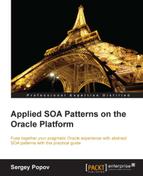In this book, you will find a number of styles of text that distinguish between different kinds of information. Here are some examples of these styles, and an explanation of their meaning.
Code words in text, database table names, folder names, filenames, file extensions, pathnames, dummy URLs, user input, and Twitter handles are shown as follows: "The xsd:any element is at the upper level in this hierarchy; it has an equivalent object in OOP."
A block of code is set as follows:
Public SearchObject getSearchResultObject() throws Exception {
try{
InputStream source = getResultStream(search_url);
Reader reader = new InputStreamReader(source);
Gson gson = new Gson();
SearchObject response = gson.fromJson(reader, SearchObject.class);
reader.close();
return response;
}
catch (Exception e){
log.error(getClass().getSimpleName(), "Error for URL " + search_url, e);
}
return null;
}When we wish to draw your attention to a particular part of a code block, the relevant lines or items are set in bold:
//invoking parser
execute immediate BEGIN '||v_parser||'(:1, :2, :3, :4 ); END;' USING IN ip_lob, IN v_msgid, OUT v_status, OUT v_status_text;Any command-line input or output is written as follows:
loadjava -grant public –user <xdbuser>/<xdbuserpwd>@<XDBSID> CustomServlet.class
New terms and important words are shown in bold. Words that you see on the screen, in menus or dialog boxes for example, appear in the text like this: "The CTUMessage payload is our generic message container."
